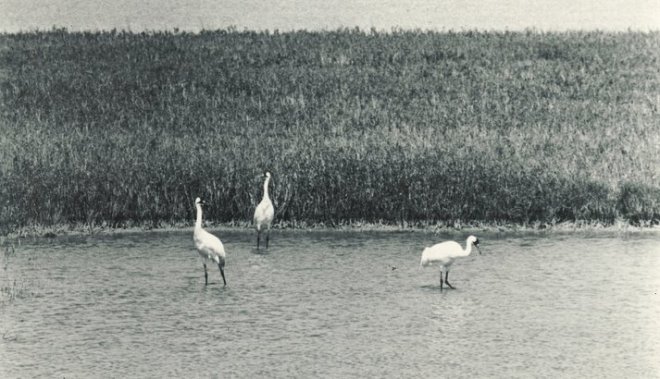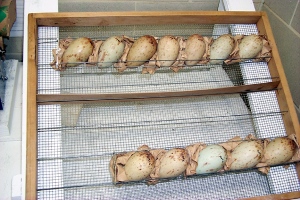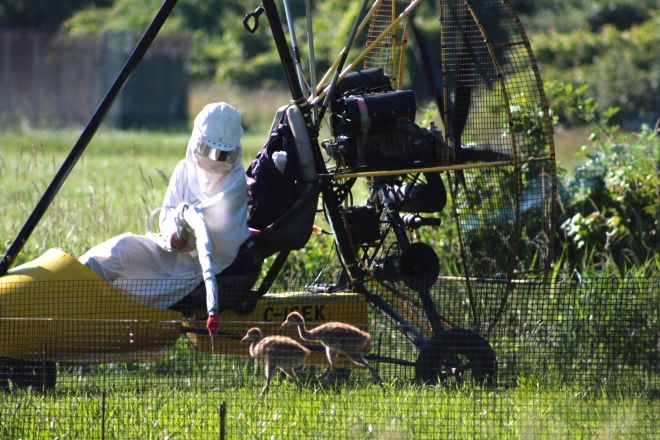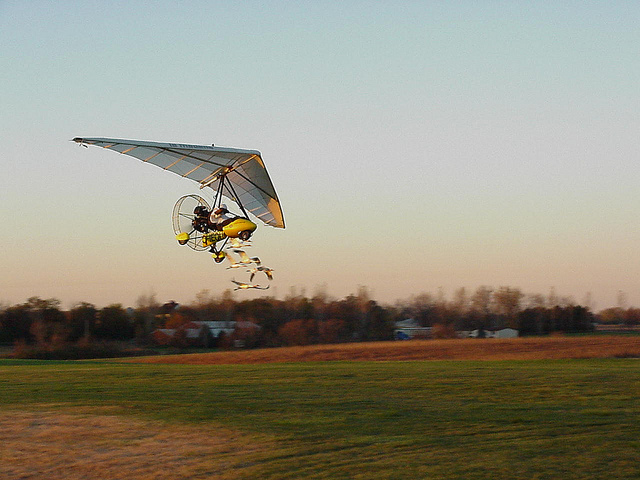Will whooping crane chicks hatch and survive to fledge in Wisconsin this year? That’s always the question at nesting season, but the need to get a ‘Yes!’ for an answer is growing more urgent.
Add to that basic question some other urgent ones as well. Will the cranes again abandon many nests when they are driven from them by clouds of tiny, biting black flies? Will they re-nest after black fly season? It’s been a cold, frozen spring in Wisconsin – will there even be a black fly season that coincides with crane-nesting season this year? And finally, when a chick does hatch will its’ crane parents be able to protect it until it can fly away from danger on its own?
As reported last week in The Badger and the Whooping Crane, although there have been many nests built by the whooping cranes of the Eastern Migratory Population since 2005 (over 130), far too few chicks have hatched and survived. Only 29 chicks have hatched, and a mere half-dozen of those survived to fledge – 1 chick in 2006, 2 in 2010, 2 more in 2012, and 1 in 2013.

A USFWS photo of a whooping crane pair with two tiny chicks at Necedah NWR in 2010 – one of the few breeding seasons to yield “survivors.”
An experiment to suppress the biting black flies that seem to be driving the cranes off their nests at Necedah National Wildlife Refuge was conducted during the cranes’ breeding seasons of 2011 and 2012. It did result in improved incubation success, but Peter Fasbender, the Whooping Crane Eastern Partnership co-chair told me last week in an email that incubation improvement, by itself, wasn’t enough.
WCEP Makes the Case for More Study and More Second Nests
Nine chicks were hatched in 2012 – a record for the EMP, but only two survived to fledge, and join their parents on migration. The low survival rate–particularly of chicks from first nests–is also what concerns WCEP, Fasbender said. “Black fly emergence during the incubation phase contributes to failure in this area,” (nesting) “but our study has shown this is only part of the problem.”
Fasbender added that WCEP observations show that chicks have a much better chance of surviving to fledge if they are hatched from re-nests–the second nests that whooping crane pairs sometimes build if their first nesting attempt has failed. Thus, this year WCEP, is tackling the problems of ‘nest abandonment’ and ‘low chick survival’ with new tools, one of them being an emphasis on getting at least some of the cranes to re-nest. WCEP plans to remove eggs from half the nests early in the spring. (The undisturbed nests will act as a control group, Fasbender said.) The goal of doing this is to encourage whooping crane pairs to re-nest later in the season, when the black fly emergence has passed and there is a higher chance of chick survival, as well.
The second new tool that WCEP has announced this year is a $210,000 grant that has been awarded to Necedah NWR from the U.S. Fish and Wildlife Service Cooperative Recovery Initiative, to “expand the limited understanding of multiple factors that influence nesting whooping cranes.” Necedah was one of only four refuges selected to receive such a grant this year. It will support 3 years of efforts to study and manage the cranes’ nesting season.
More History of the Black Fly Problem
Curious for more information about the black fly problems and the experiment to suppress them (and what, if anything, that might mean for the future) I visited WCEP’s webpages about its nest productivity studies, as well as “The Whooping Crane Eastern Partnership Five Year Strategic Plan 2011 – 2015,” and its “March 2014 Status Report & Updates.”
Two specific black fly species that target birds to feed on have been identified at Necedah NWR. I learned they emerge with the first significant warm weather every year, always seeming to coincide with the whooping cranes’ nesting season–identified at WCEP’s “History of Nesting Efforts” as late April to mid-June. By 2008 there was enough anecdotal observations of large numbers of flies near nesting cranes, and photos of flies all over eggs in abandoned nests and that, combined with “lower than expected reproductive success,” prompted WCEP to launch “detailed nesting studies in 2009 and 2010,” and also, to search for an alternate future breeding territory to replace Necedah.
Whooping crane nesting success went up in 2012, after WCEP implemented the experimental black fly suppression program in both 2011 and 2012. This involved identifying the breeding sites of the flies and treating them with Bti (Bacillus thuringiensis israelensis), described as a biological control agent. The result was that the black fly population decreased, and in 2012, 9 whooping crane chicks were hatched, though as previously mentioned, only 2 chicks survived to fledge. As committed as WCEP is to addressing the low chick survival through more study and re-nesting, a “Bti Summary Statement for 2014″ reports that talks will continue within WCEP about the use of Bti as a management tool (rather than just as an experiment) at some point in the future.
A New Breeding Territory for Whooping Cranes in Wisconsin
As mentioned above, WCEP began a search for a second location for the cranes’ nesting territory once the black fly problem was positively identified with Necedah. By 2011 this alternative, free of any large-scale black fly problem, had been identified on the eastern side of the state and chicks were being trained to fly with the ultralights at White River Marsh State Wildlife Area, and DAR chicks were being released at Horicon NWR. This would insure that the youngest cranes would migrate back to these areas and eventually, when mature, form pairs and build nests there.
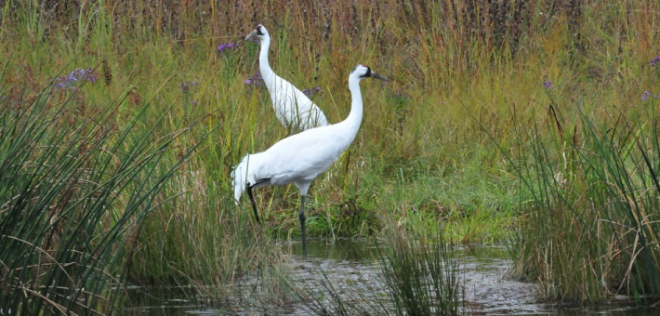
An adult whooping crane pair that live within the captive population at the International Crane Foundation in Baraboo. (Photo by Joel Trick, used courtesy of WCEP)
Today there are 15 adult whooping cranes–7 that are DAR (direct autumn release) cranes and 8 ultralight-trained birds–that were the first to start their migrations from these eastern Wisconsin locations in 2011. They are now 3 years old, and generally thought too young to form pair bonds and produce fertile eggs. But it is hoped it won’t be long now before this group does form pairs and begins to produce chicks.
In fact, it was reported at the Operation Migration Field Journal, that two of the 2011 bird have indeed paired, and built a nest in the White River Marsh SWA. It was discovered by a Wisconsin DNR pilot on April 24th, and reported by Journey North as still active April 30th. A good sign? You bet!
Please stay tuned as we learn whatever answers the 2014 nesting season may yield.

